#theriodont
Text
Vegan Krissy Lynn Loves to Eat BBC Sausage! Part 3 of 3– Immoral Productions
Jasmine Jae suck Ike Diezel young cock before getting penetrated
Sexy Sultry Hot Big Boobs Girl Rubbing HUGE TITS and playing with Wet hard Nipples with Juices alone in the bathroom
fatima segovia chuecona en chongo
Hot Maddy tribs pussy with Carmen
Horny wife reverse cowgirl
Ebony riding bbc
Bbw plays with her bouncy boobs
Beautiful girl masturbate toys public show
Gorgeous companion Shy Love plays with her pussy and gets her tight asshole fingered
#overwatch#Norean#picrotoxic#slighty#theriodont#coppernose#carpogenous#cataloguer#QM#Brize#polyarthrous#eidolons#prolapsing#dermatopathia#electrometeor#symtab#repawn#Delphi#sin-burthened#Harrod
1 note
·
View note
Text
#i remembered that i can just Make Polls whenever i want so take this#a very important question#bug game#if u dont know what a theriodont is look it up#that group of animal is very Grumpus Adjacent#why are the poll time options still a single day or an entire week?? come on now let me make it like 3 days
53 notes
·
View notes
Text

DINOVEMBER DAY 8: 255MYA, WUCHIAPINGIAN STAGE; URAL REGION, RUSSIA
It is now the late Permian, and a large Inostrancevia has brought down a Scutosaurus. She is a gorgonopsid, a type of theriodont that have become top predators in this world, characterised by the incisors that have grown into huge sabre-teeth that let her kill prey much bigger than herself fairly efficiently. Most gorgonopsids don’t need to be much larger than 1 or 2m long, the size of a big dog, but this Inostrancevia is bear-sized at about 3.5m long. She is the greatest predator in all of Pangea; little does she know her world is collapsing around her.
While synapsids still dominate the Permian, the sauropsids are carving out a place for themselves. A group of sauropsids called the reptiles have emerged; while most stick to the ancestral lizard-like bodyplan, some are competing with the amphibians for the role of semi-aquatic ambush hunter, and one group, the pareiasaurs, have replaced large bodied terrestrial herbivores like Moschops. Scutosaurus is one of the largest pareiasaurs, some adults more than a tonne and a half in weight, and his thick skin is peppered with bony scutes to defend against the teeth of voracious gorgonopsids. For this particular Scutosaurus, his protection has come to nought.
Unbeknownst to predator and prey, the world of the Permian has been changing. The single supercontinent, Pangea, is beginning to tear at the seams. This has triggered much volcanic activity, with the most severe eruptions in Siberia releasing massive amounts of sulphur into the atmosphere. The Permian has also been a time of warming; 50 million years ago, there was still ice at the poles, but now most land is scorching desert. This ash-choked hothouse climate has caused the oceans to lose oxygen and become dangerously acidic, which in turn has caused oceanic ecosystems to collapse. This domino effect will reach the land too, creating the worst extinction event in the entirety of the earth's history. 95% of marine life will die out, as well as 70% of life on land, earning this the title of 'The Great Dying'. The Permian, and the age of the synapsids, is over.
20 notes
·
View notes
Text
gorons are theriodonts TO ME
3 notes
·
View notes
Photo

I’m binging my way through Primeval for about the hundredth time, cause why not, its one of my favorite shows, and I took a break from comic work to doodle a gorgonopsid.
Lookit those teef! Who couldn’t love that giant Permian puppy? I love him so ❤️ I would like one or two or five, please!
60 notes
·
View notes
Photo

The Spike-Pointed Tree Gorgon
A creature design assignment for Kunkka's class! After assembling the habits and anatomy, we put the creature into a poster layout.
After that, I tried going for a Speculative Evolution angle on the poster! Here's my Permian fishing cat+bird+insect ambush predator.
Big thanks to @danbensen for help figuring this animal's ancestry and bits of anatomy. Going for the gastralia + gorgonopsid angle was his input
Full view to read the text. You can look below to see the detail shots and a version of the poster without the text.



19 notes
·
View notes
Text
Shut up about the saber toothed cats, we need to give more love to the Gorgonopsids!

They were rocking the saber teeth long before the kitty cats even existed, roughly over 200 million years before the saber tooth cats! Yet I don’t see anyone talking about them. Ffs the name Gorgonops literally translates to “Gorgon face”! They were named after a creature from Greek mythology! You know, the snake ladies with snake hair? Medusa was one, who is one of the most famous monsters in the world? How badass is that?

Hell they even predated the dinosaurs for crying out loud! This ain’t no dinosaur, not even a reptile either. These are proto mammals, a group of animals that are closely related to mammals that split away from the ancestors to mammals before mammals evolved. They do look a little reptilian in posture tho.

Speaking of mammal and reptile stuff, it isn’t really known for sure whether or not these animals had scales or were covered in fur. Or perhaps a bit of both even! Just imagine coming across one of these croco-dogo’s roaming around covered in scales and fluff! I think that’d be both oddly cute and very terrifying. Also, the shape of their skulls... look at that shnoz! It deserves a boop!

Come on people! The Gorgonopsids didn’t go down in history as the only group of Theriodonts to go extinct from the Permian-Triassic extinction just for some hairless apes to completely ignore how cool they were and focus their attention on some bitch ass cats that stole their teeth.
17 notes
·
View notes
Note
I WOULD LOVE TO HEAR ABOUT THE EVOLUTION OF THE JAW. Teach us, Professor Pom. :D
I have no idea when you sent this so sorry if it’s late :,D
So this is referring to the tags on this post. Mandatory disclaimer that I am not an expert and this is acting on information gathered in some of the biology classes I’ve taken which discussed evolutionary “checkpoints” in the history of life on earth. I’m going to do my best to supplement any gaps in my memory with sources taken from official sources but I can’t guarantee that all the information is going to be 100% accurate because, again, I am not an expert.
THAT SAID, let’s talk about how fucking wild jaw bones are!!!
So jaw bones as vertebrates know them didn’t evolve until around 450 million years ago in the mid-paleozoic period. Up till that point vertebrates mostly consisted of fleshy tubular chordates, animals that were defined as having a central nerve cord, a “notochord” (essentially an early version of a spine), a muscular tail, and gill slits. That last one, the gill slits, were pretty important because that’s what would filter water for oxygen and food particles.
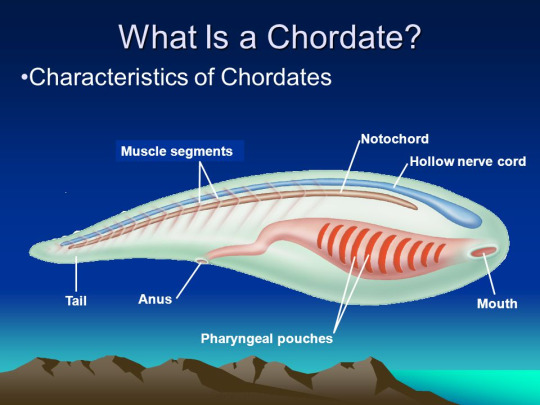
These gill slits needed to be able to have some movement and support so it could push water through them, so these slits eventually became supported by cartilaginous arches that would aid them in movement. But being squishy tubes is dangerous when you live in the same ocean as rapidly evolving predatory arthropods and cephalopods, so they started to develop skeletal supports around their gills and craniums, which also happened to aid in moving water through their gills.

Great right? Now they’re not as squishy anymore and eating is easier! But life in the ocean is still tough as hell and predators are winning the evolutionary arms race. If you don’t eat, you die. If you don’t eat fast, something else gets your meal. So how do you get food in your body faster? Bypass the filter feeding and ingest prey directly through the mouth? But then how do you get the food to go in the mouth in the first place?
Here’s where it gets interesting, because those skeletal supports slowly but surely start pushing their way forward, moving the mouth forward at and angle where prey can get funneled inside. But it doesn’t stop there! The bones continue to move closer together, harden, thicken, and externalize, turning the squishy tubes into living fish traps.
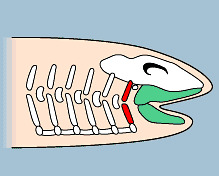
So now you have the beginnings of a jaw, but they can’t move very much. You pretty much have to swim around and hope you move faster than whatever you’re chasing (or in the case of most modern jawless fishes, you suction onto another animal, drill in, and suck down the juices). But this is still an arms race, and whatever can eat the fastest comes out on top.
Enter the Placoderm
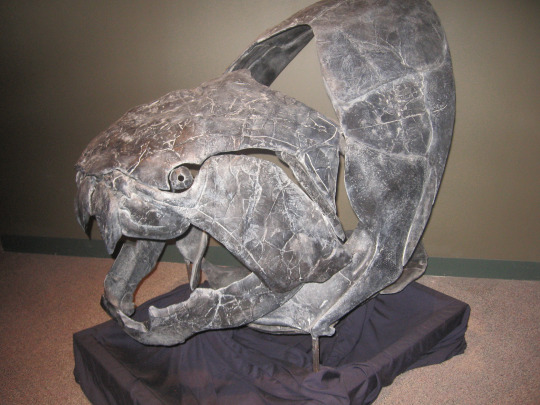
Placoderms are some of the first vertebrates to develop a functional jaw the way we know it today. Their plated heads and mobile lower jaws allowed them to slice through bigger and bigger prey, to the point where Dunkleosteus was, for a time, the largest predator in the ocean.
Imagine, if you will, what that must’ve been like. You’re swimming around, minding your own business, trying to find food. Suddenly, you see this–

–coming in your direction at mach fuck, and the next moment you’re gone. The oceans went from a dominance of beaks and mandibles to the dominance of skeletal slicing machines in the evolutionary equivalent of overnight.
And from there jaws only diversified. Jawed fishes, amphibians, reptiles, early birds, all had some kind of jaw to help them eat or communicate or breathe. But the journey isn’t over yet.
Enter the Theriodont
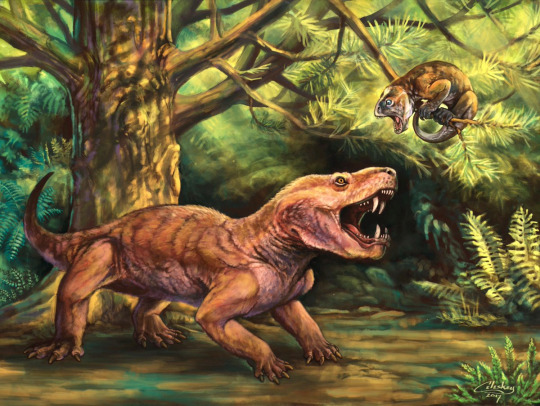
Theriodonts were a group of therapsid, early reptiles beginning to evolve into mammals, which had started to do some interesting things with their jaws. First, some of the jaw bones previously used as connectors between the upper and lower jaw moved upwards, supporting the aural structures and becoming early eardrums, allowing them to track sounds better. Second, the teeth and space for the jaws became larger, so they were far more efficient at hunting than some of their smaller-jawed relatives. More space for teeth meant bigger teeth and more teeth, which could be further compartmentalized in the jaw.
Enter the Cynodont, one of the first mammal-like reptiles with a fully differentiated jaw! See, before this teeth could be triangular, conical, even practically nonexistent, but they were pretty much always all roughly the same size and shape. Cynodont changed that. Its front teeth (what we might recognize as an early precursor to the canines) were elongated for burrowing, while its back teeth (what we might recognize as an early precursor to the molars) were flat and thick, made for grinding up food.

This amazing development eventually led to the incredible diversity in teeth we see today in mammals, from incisors to canines to molars to even more specialized jaw structures like baleen.
And it’s just wild to me that teeth in general are the result of bony structures pushing through the squish in the mouths of early fish to become the ultimate eating machine.

#butterfly-apocalypse#pluckypomanswers#ask to tag#evolutionary biology#evolution of the jaw#this was fun!
36 notes
·
View notes
Note
Hello again. As I asked about burnetiamorphs and you said they're not gorgonopians.. well, I searched some info and got that your answer partially incorrect - they are placed as gorgonopians by Ivakhnenko, and E. Amson & M. Laurin place them and other "biarmosuchians" as sister group to theriodonts (their classification is found on Suomi Wikipedia at least).. But which variant is the most correct one: gorgonopian, early therapsid or "theriodont sister branch"?
I’m not at liberty to say at the moment.
For the record Russian synapsid paleontologists tend to be roughly a decade behind everyone else taxonomically, I have no idea why
2 notes
·
View notes
Photo

// for @theriodont
#orlando furioso#renaissance#ferrara#rinascimento#lingua italiana#italiano#poetry#poesia#ludovico#ariosto#este#amore#love#torment#quote#aesthetic#typewriter#risposta
13 notes
·
View notes
Text
I was tagged by @scorpion-flower !
Rules: Tag 9 users you want to get to know better
How old are you? : 19
Current job? : I’m a student, but when I can spare time I work for catering
Dream job? : This is pretty improbable, but I’ve always dreamed of working in one of the big museums or art galleries in Europe.
What are you talented at? : Not much, really. I played soccer for 10 years and flute for 7, so I’m kind of good at those. I’m also obsessed with art, especially art from the Italian Renaissance, so I can usually talk about those at length.
What is a big goal you are working towards/have already achieved? : I wanted to run a 5k without walking, and I did!
What’s your aesthetic? : Flowers, cottages in the English countryside, art, classical architecture, old books.
Do you collect anything? : I collect all sorts of things (receipts, tickets, pennies, etc.) when I travel. It all goes in a travel journal.
What’s a topic you always bring up in a conversation? : I have a bad habit of closing myself off and occasionally bursting and being way too talkative and annoying in conversations, so I guess myself? But not in a good way.
What’s a pet peeve of yours? : Mansplaining, when people don’t close the door all the way, and the sound of spoons/forks grinding against teeth
Good advice to give? : Be kind
Recommend three songs: (1) Mi Fido Di Te by Jovanotti (2) Cantique de Jean Racine by Gabriel Fauré (3) Rhythm of Love by Plain White T’s
Tagging: @hoodygirl @frustrationinexcelsis @exquisitelyadequate @apope14 @theriodont @la-stravagante @ivegotabetterfrick @ghostygurt
4 notes
·
View notes
Photo
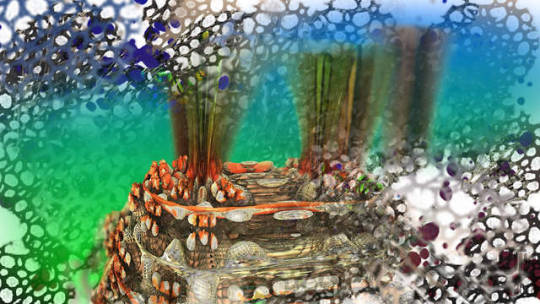
cherishable theriodont by Jared Haer Tempests Unresistedness Study #paint #digitalart #Python #fineart #tweegram #psychedelicArt
0 notes
Photo


SCIENCE!
7 notes
·
View notes
Text
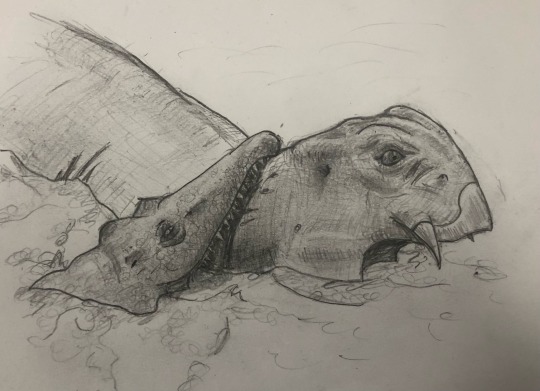
DINOVEMBER DAY 9: 250MYA, ONELEKIAN STAGE; TRANSANTARCTIC MOUNTAINS, ANTARCTICA
The aftermath of The Great Dying has been severe, and the world of the Triassic is shaping itself to be very different to the Permian. The once dominant synapsids have been whittled down to two small groups; a group of anomodonts called the dicynodonts, like this Lystrosaurus, and a group of theriodonts called the cynodonts; our own dog-like ancestors. All life has suffered, apart from slimy sulphur-eating algae that in normal conditions would be restricted to volcanic pools. Temperatures are still high, the deserts are still vast and inhospitable, and Pangea continues to fracture. Only the coasts are habitable, and the tropicals are ravaged by seasonal supermonsoons generated from the air currents created by the one sea that stretches from pole to pole. These conditions will persist for the rest of the Triassic, shaping the world and it's inhabitants.
Lystrosaurus is an unlikely looking survivor, but for a while this strange piglike animal was the most common vertebrate on land. It's favoured habitat, coastal lowland marshes, was relatively untouched by the extinction, and it's lifestyle of choice, wading through the wetlands like a hippo, using it's tusks to dig for roots, and burrowing for shelter has helped them weather the storm. However, this cannot save them from the revolution to come.
Whilst crossing a channel of deeper water, this Lystrosaurus has encountered one of the numerous reptilian predators of the Triassic; a hook-nosed Proterosuchus, equally at home on land and in the water. Her serrated teeth sink into the the neck of the Lystrosaurus as her jaws clamp down on her, ready to drag her beneath the surface. The Lystrosaurus gasps as her lungs fill with a mix muddy water and her own blood. Reptiles are quickly rising to fill the power vacuum left by the synapsids, and the largest reptilian predators like the big-headed Erythrosuchus are already as big as the largest synapsid predators of the Permian. This is one of the most dangerous and unstable times in the earth's history, and the animals of the Triassic must be as fierce as the threats that they face. Welcome to the age of reptiles.
18 notes
·
View notes